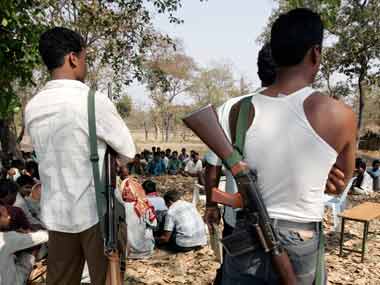The RSS recently organised a seminar focussed on identifying the “Urban Naxals” and how they are serving as the front for the banned Communist Party of India (Maoist), the main party leading Left-Wing Extremism in India. At the core of the event was a fact-finding report on Bastar, a Maoist-affected region in Chhattisgarh, prepared by an 11-member team, which identifies itself as UDAAN, comprising academicians, lawyers and teachers. The report claims to have busted several myths and issues in societal perception of the Left-Wing Extremism in India (and Chhattisgarh) during its four-day visit of Bastar in 2017 including that “the ideological battle is not being fought in the jungles but in urban areas”. [caption id=“attachment_4449495” align=“alignleft” width=“380”] Representational image. Reuters[/caption] Making a note that the CPI (Maoist) has a dedicated plan to mobilise the urban population, it states that “intellectuals working as academicians, lawyers, media persons act as sympathisers of Maoist activities and spearhead the movement by making it appear an ideological war against caste and class”. “In urban areas,” the report says, citing a Maoist document from its Ninth Congress of Maoists, “these secret organisations perform the important task of propagating the party (Maoist) line among various sections of the masses. They are the main vehicles of revolutionary propaganda…” and “the formulation and propagation of the revolutionary standpoint on various issues of the day — particularly the issues affecting the section which they are organising.” The report also says that “the urban sympathisers of the Maoists, working under the disguises of ‘constitutional framework’ use the State machinery to weaken the State” and use “the provisions of National Human Rights Commission, Supreme Court and other Courts to the advantage of Maoists, the enemies of the State”. The CPI (Maoist) has “an urban policy to run their version of revolutionary movement”, it says. These observations are important especially since “Urban Naxals” have become a part of the national discourse following the arrest of five human rights activists in a country-wide operation on 29 August. Stating that Maoists works in a proper organisational structured way, the emphasis of Left-Wing Extremism, the report says that “their long-term plan is to move to urban areas after their priority work is successfully done in countryside.” The report also claims that unlike what is propagated, it’s not the government but Maoists or Naxals who are responsible for the backwardness of Bastar. “The Maoists deeply resent any development work and put their full force to stop it. It suits them if the children do not get educated, roads are not constructed or the modern amenities do not reach the villagers in order to continue their reign of terror.” It says that while in one hand (Maoists) do not let development happen, their urban sympathisers use this to claim that “villagers are protesting in a violent way” because there is “no development”. The fact-finding mission claims to have been inspired to take the study after it found “disturbing news and views published in national and international media about Chhattisgarh, like some documentaries shown on BBC and Al-Jazeera” and how T__he Washington Post has termed Chhattisgarh as the “rape capital” of the world and in another example, The Wire has described the state as “Black hole of world civilisation”. Though it says that there are no data to support or reject that Maoism has aided trafficking from villages of their dominance. The report claims, “Buses full of children keep going to Hyderabad from Jagdalpur and from there they are supposedly being trafficked to other cities of the country.” It also claims that the Maoist movement in Bastar was not indigenous, but fuelled by Left extremists who moved into the Chhattisgarh from neighbouring Andhra Pradesh and Telangana in the 1980s. The report also cites how “irrational and inadequate Government policy and means” including designating the Abujmar hills area, a safe haven for fugitive Maoists, as a “No Entry” Zone in the 1980s, helped the spread of Maoists in Chhattisgarh. “The existing vacuum of governance in the area was eventually made worse by extremists through their well-known operational procedure of killing the heads of local administration, the _sarpanch_s and _panch_s. This sudden and strong violence created an ambience of terror in the tribes,” it said. It says that Maoism in Chhattisgarh is located in a dense forest area of around 4,000 square kilometres of dense forest area including Abujmar Hills. “It was in 2009 when the government changed the status of the region, but, by then the damage had already been done. The isolation had completely worked in favour of the fugitive Maoists. As by then they had mastered the terrain and also specialised in the guerrilla warfare,” it adds. The report says that the Chhattisgarh terrain is “more hostile than other areas of Maoist influence in India” and that the “presence of high level of iron ore in the land makes it difficult for metal detectors to work in case of pressure bombs and other types of explosive material used by Maoists”.
A fact-finding mission report on Naxals, recently unveiled at an RSS event states that “intellectuals working as academicians, lawyers, media persons act as sympathisers of Maoist activities and spearhead the movement by making it appear an ideological war against caste and class”
Advertisement
End of Article


)

)
)
)
)
)
)
)
)



